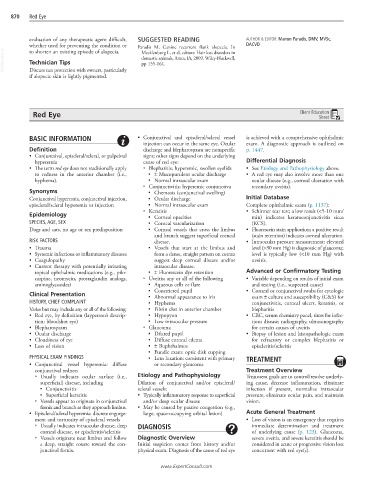Page 1730 - Cote clinical veterinary advisor dogs and cats 4th
P. 1730
870 Red Eye
evaluation of any therapeutic agent difficult, SUGGESTED READING AUTHOR & EDITOR: Manon Paradis, DMV, MVSc,
whether used for preventing the condition or Paradis M: Canine recurrent flank alopecia. In DACVD
VetBooks.ir Technician Tips domestic animals, Ames, IA, 2009, Wiley-Blackwell,
to shorten an existing episode of alopecia.
Mecklenburg L, et al, editors: Hair loss disorders in
pp 155-161.
Discuss sun protection with owners, particularly
if alopecic skin is lightly pigmented.
Red Eye Client Education
Sheet
BASIC INFORMATION • Conjunctival and episcleral/scleral vessel is achieved with a comprehensive ophthalmic
injection can occur in the same eye. Ocular exam. A diagnostic approach is outlined on
Definition discharge and blepharospasm are nonspecific p. 1447.
• Conjunctival, episcleral/scleral, or palpebral signs; other signs depend on the underlying
hyperemia cause of red eye: Differential Diagnosis
• The term red eye does not traditionally apply ○ Blepharitis; hyperemic, swollen eyelids • See Etiology and Pathophysiology above.
to redness in the anterior chamber (i.e., ■ ± Mucopurulent ocular discharge • A red eye may also involve more than one
hyphema). ■ Normal intraocular exam ocular disease (e.g., corneal ulceration with
○ Conjunctivitis; hyperemic conjunctiva secondary uveitis).
Synonyms ■ Chemosis (conjunctival swelling)
Conjunctival hyperemia, conjunctival injection, ■ Ocular discharge Initial Database
episcleral/scleral hyperemia or injection ■ Normal intraocular exam Complete ophthalmic exam (p. 1137):
○ Keratitis • Schirmer tear test; a low result (<5-10 mm/
Epidemiology
■ Corneal opacities min) indicates keratoconjunctivitis sicca
SPECIES, AGE, SEX ■ Corneal vascularization (KCS).
Dogs and cats, no age or sex predisposition ■ Corneal vessels that cross the limbus • Fluorescein stain application; a positive result
and branch suggest superficial corneal (stain retention) indicates corneal ulceration.
RISK FACTORS disease. • Intraocular pressure measurement; elevated
• Trauma ■ Vessels that start at the limbus and level (>30 mm Hg) is diagnostic of glaucoma;
• Systemic infectious or inflammatory diseases form a dense, straight pattern on cornea level is typically low (<10 mm Hg) with
• Coagulopathy suggest deep corneal disease and/or uveitis.
• Current therapy with potentially irritating intraocular disease.
topical ophthalmic medications (e.g., pilo- ■ ± Fluorescein dye retention Advanced or Confirmatory Testing
carpine, neomycin, prostaglandin analogs, ○ Uveitis; any or all of the following • Variable depending on results of initial exam
aminoglycosides) ■ Aqueous cells or flare and testing (i.e., suspected cause)
Clinical Presentation ■ Constricted pupil • Corneal or conjunctival swabs for cytologic
■ Abnormal appearance to iris exam ± culture and susceptibility (C&S) for
HISTORY, CHIEF COMPLAINT ■ Hyphema conjunctivitis, corneal ulcers, keratitis, or
Varies but may include any or all of the following: ■ Fibrin clot in anterior chamber blepharitis
• Red eye, by definition (layperson’s descrip- ■ Hypopyon • CBC, serum chemistry panel, titers for infec-
tion: bloodshot eye) ■ Low intraocular pressure tious disease; radiography, ultrasonography
• Blepharospasm ○ Glaucoma for certain causes of uveitis
• Ocular discharge ■ Dilated pupil • Biopsy of lesion and histopathologic exam
• Cloudiness of eye ■ Diffuse corneal edema for refractory or complex blepharitis or
• Loss of vision ■ ± Buphthalmos episcleritis/scleritis
Fundic exam: optic disk cupping
■
PHYSICAL EXAM FINDINGS ■ Lens luxation: consistent with primary TREATMENT
• Conjunctival vessel hyperemia: diffuse or secondary glaucoma
conjunctival redness Treatment Overview
○ Usually indicates ocular surface (i.e., Etiology and Pathophysiology Treatment goals are to control/resolve underly-
superficial) disease, including Dilation of conjunctival and/or episcleral/ ing cause, decrease inflammation, eliminate
Conjunctivitis scleral vessels: infection if present, normalize intraocular
■
Superficial keratitis • Typically inflammatory response to superficial pressure, eliminate ocular pain, and maintain
■
○ Vessels appear to originate in conjunctival and/or deep ocular disease vision.
fornix and branch as they approach limbus. • May be caused by passive congestion (e.g.,
• Episcleral/scleral hyperemia: discrete engorge- large, space-occupying orbital lesion) Acute General Treatment
ment and tortuosity of episcleral vessels • Loss of vision is an emergency that requires
○ Usually indicates intraocular disease, deep DIAGNOSIS immediate determination and treatment
corneal disease, or episcleritis/scleritis of underlying cause (p. 123). Glaucoma,
○ Vessels originate near limbus and follow Diagnostic Overview severe uveitis, and severe keratitis should be
a deep, straight course toward the con- Initial suspicion comes from history and/or considered in acute or progressive vision loss
junctival fornix. physical exam. Diagnosis of the cause of red eye concurrent with red eye(s).
www.ExpertConsult.com

